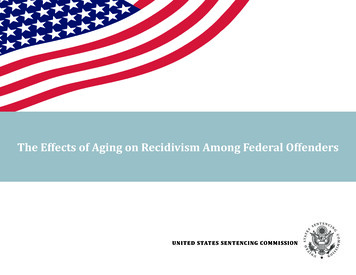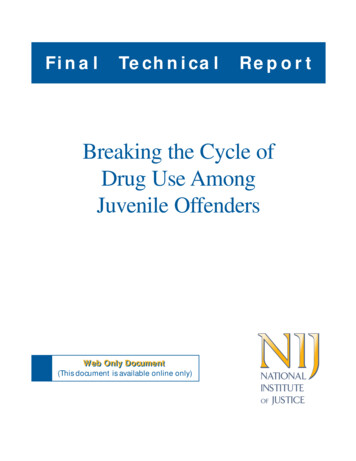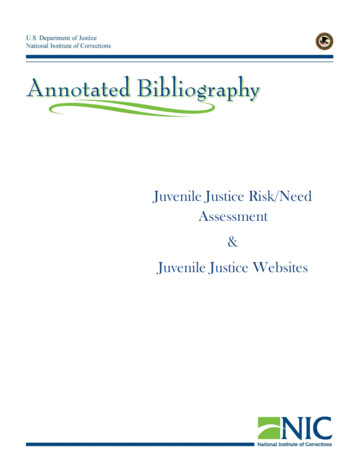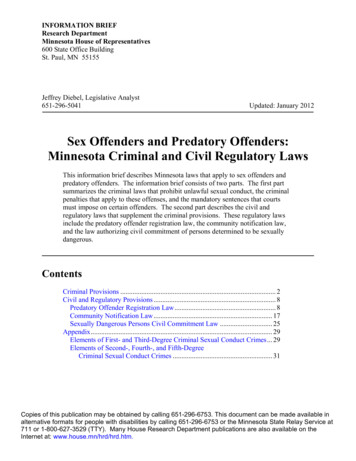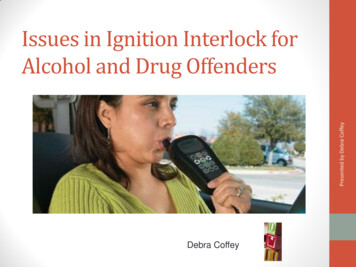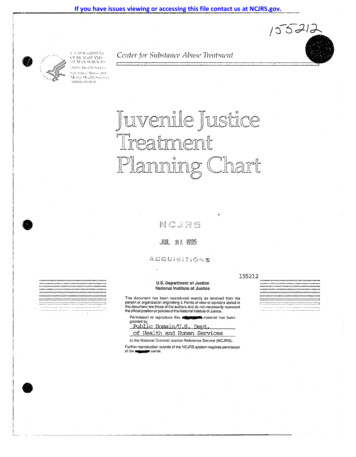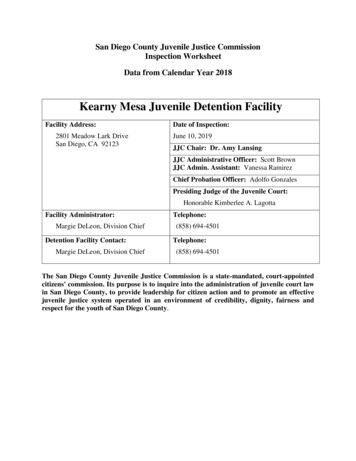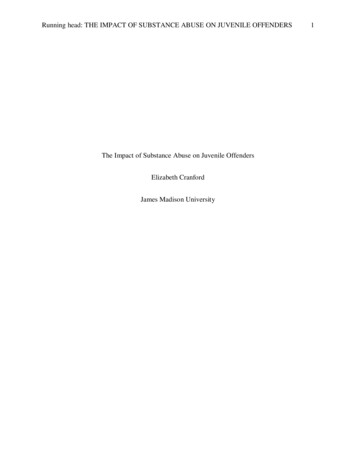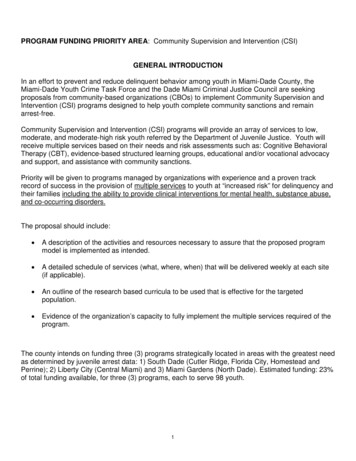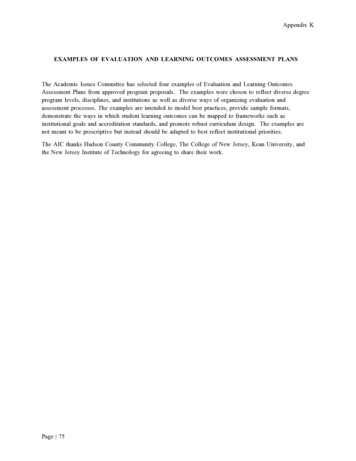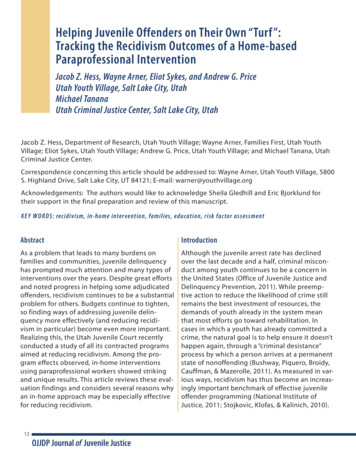
Transcription
Helping Juvenile Offenders on Their Own “Turf”:Tracking the Recidivism Outcomes of a Home-basedParaprofessional InterventionJacob Z. Hess, Wayne Arner, Eliot Sykes, and Andrew G. PriceUtah Youth Village, Salt Lake City, UtahMichael TananaUtah Criminal Justice Center, Salt Lake City, UtahJacob Z. Hess, Department of Research, Utah Youth Village; Wayne Arner, Families First, Utah YouthVillage; Eliot Sykes, Utah Youth Village; Andrew G. Price, Utah Youth Village; and Michael Tanana, UtahCriminal Justice Center.Correspondence concerning this article should be addressed to: Wayne Arner, Utah Youth Village, 5800S. Highland Drive, Salt Lake City, UT 84121; E-mail: warner@youthvillage.orgAcknowledgements: The authors would like to acknowledge Sheila Gledhill and Eric Bjorklund fortheir support in the final preparation and review of this manuscript.KE Y WORDS: recidivism, in-home intervention, families, education, risk factor assessmentAbstractIntroductionAs a problem that leads to many burdens onfamilies and communities, juvenile delinquencyhas prompted much attention and many types ofinterventions over the years. Despite great effortsand noted progress in helping some adjudicatedoffenders, recidivism continues to be a substantialproblem for others. Budgets continue to tighten,so finding ways of addressing juvenile delinquency more effectively (and reducing recidivism in particular) become even more important.Realizing this, the Utah Juvenile Court recentlyconducted a study of all its contracted programsaimed at reducing recidivism. Among the program effects observed, in-home interventionsusing paraprofessional workers showed strikingand unique results. This article reviews these evaluation findings and considers several reasons whyan in-home approach may be especially effectivefor reducing recidivism.Although the juvenile arrest rate has declinedover the last decade and a half, criminal misconduct among youth continues to be a concern inthe United States (Office of Juvenile Justice andDelinquency Prevention, 2011). While preemptive action to reduce the likelihood of crime stillremains the best investment of resources, thedemands of youth already in the system meanthat most efforts go toward rehabilitation. Incases in which a youth has already committed acrime, the natural goal is to help ensure it doesn’thappen again, through a “criminal desistance”process by which a person arrives at a permanentstate of nonoffending (Bushway, Piquero, Broidy,Cauffman, & Mazerolle, 2011). As measured in various ways, recidivism has thus become an increasingly important benchmark of effective juvenileoffender programming (National Institute ofJustice, 2011; Stojkovic, Klofas, & Kalinich, 2010).12OJJDP Journal of Juvenile Justice
Given the variability in measurement approachesand state system characteristics, local juvenilerecidivism rates vary widely—ranging from 12%to 55%, according to a report from the Officeof Juvenile Justice and Delinquency Prevention(Snyder & Sickmund, 2006). This report notes thatwhether documented through rates of arrest,court referral, conviction, or correctional commitment and status changes, “virtually all measuresof recidivism underestimate reoffending sincethey only include offending that comes to theattention of the system” (Snyder & Sickmund,2006, p. 234).Despite the problem’s scope, even one instance ofa youth not reoffending means not only less burden on the system, but also the addition of thatone individual’s positive energy and engagementin society. To increase such outcomes, a wide variety of efforts have emerged. Common approachesto reducing recidivism have included institutionbased and therapy programs such as aggressionreplacement training, juvenile drug courts, interagency cooperation programs, restorative justiceinterventions, and a range of individual clinicalinterventions (Allard, Ogilvie, & Stewart, 2007).To complement these formal institutional andclinical efforts, an array of community-based services have also been developed—from intensivesupervision, life skills development, and adolescent diversion projects to alternative schools,vocational rehabilitation programs, and halfwayhouses (Allard et al., 2007).As funding options are being reduced, decisionsabout where to best invest time and resourcesgrow increasingly crucial. This has naturallyprompted heightened attention toward outcome research that identifies those interventionswith the greatest success in reducing recidivism(Latessa & Lowenkamp, 2006). Generally speaking,community-based efforts to reduce recidivismhave proven more successful than their institutional counterparts (Andrews et al., 1990; Dembo,Wareham, Poythress, Cook, & Schmeidler, 2000;Dembo, Wareham, Schmeidler, & Chirikos, 2005;Henggeler & Schoenwald, 2011; Lipsey, 1999).Across institutional and community programs,however, one barrier to improved recidivismremains especially salient: Like an alcoholicreturning to the same home atmosphere following successful treatment, youth who return to asimilar family environment when released fromtreatment are clearly at increased risk of reoffending. Regardless of improvements resultingfrom treatment, if the home atmosphere remainsunchanged, an unacceptably high percentageof youth will likely revert to their past negativebehaviors.From such awareness, conventional programminghas sought to invoke family participation as muchas possible—from institutional parent involvement and family-integrated transitions to multidimensional treatment foster care and a variety offamily therapy programs (e.g., functional familytherapy or multisystemic therapy). In a metaanalysis of 35 experimental studies of interventions for adjudicated youth, interventions thatdirectly involved family members reduced recidivism at greater rates than more conventionalyouth-focused services (Latimer, 2001). Whilethe addition of any family component to a program appears to improve outcomes and reducerecidivism (Timmons-Mitchell, Bender, Kishna,& Mitchell, 2006), one particular way of workingwith families is drawing increased attention.Rather than removing youth or family from ahome environment during service delivery, anin-home approach seeks to work and operatein the youth’s place of residence, on the family’sown “turf” (Hess, Barr, & Hunt, 2009). A recentDivision of Child and Family Services audit in Utahconcluded that in-home services not only resultin better outcomes for children but were alsomore cost effective in that they often “prevent . . .expensive and disruptive foster care placements”(Office of the Legislative Auditor General, 2011).The genre of in-home interventions is heterogenous, differing most basically with regardto who conducts the service. The interventions studied most often involve professionalOJJDP Journal of Juvenile Justice13
therapists entering the home (e.g., TimmonsMitchell et al., 2006). Although there are obvious benefits to having trained clinicians offeringneeded services, such interventions are typically expensive. According to some psychological research, trained paraprofessionals can beeffective agents of change, with outcomes oftenequivalent or comparable to those achieved byprofessionals (Boer, Wiersma, Russo, & Bosch,2005; Bright, Baker, & Neimeyer, 1999; Durlak,1979; Montgomery, Kunik, Wilson, Stanley, &Weiss, 2010). In terms of in-home paraprofessional interventions, some impressive outcomeshave been documented across diverse situations,including those targeting risk factors of lowincome new mothers (Katz et al., 2011; Olds et al.,2004; Walkup et al., 2009); adults facing depression or anxiety (Boer et al., 2005; Montgomery etal., 2010); youth at risk for suicide (Gray, Dawson,Grey, & McMahon, 2011); and families struggling with aggressive children (Lewis, 2005).Nevertheless, the assumption that effectiveinterventions must be delivered by professionalsremains widespread.More extensive research on this subject is therefore needed. In 2010, the Utah Juvenile Courtcommissioned the University of Utah’s CriminalJustice Consortium to conduct a study of itsfunded recidivism reduction programs. This article summarizes and reports recidivism outcomesfrom that analysis, specifically of one paraprofessional-delivered in-home program that had anotable impact on helping youth avoid committing future crime.The InterventionAssessmentFamilies First is an intensive in-home intervention that has been developed and used over thelast 20 years, helping families with a variety ofemotional and behavioral problems. While it wasdeveloped within a specific agency in Utah, theintervention is based on the Teaching-FamilyModel that has been tested and applied across14OJJDP Journal of Juvenile Justicethe nation and internationally (Fixsen, Blase,Timbers, & Wolf, 2001; Lipsey & Wilson, 1998).The program is designed to teach parents andyouth essential skills that can help stabilize familyrelationships and overall home life. Many participating families live at or below the povertylevel, with associated employment struggles anddifficulty meeting basic needs for housing, clothing, and food. Youth in these families often havea history of interactions with the juvenile justicesystem.Families with youth in the juvenile justice system are referred to Families First by the juvenile courts. But before the juvenile courts refersuch youth to Families First, they evaluate eachoffender’s and family’s risk level and treatmentneeds using the evidence-based ProtectiveRisk Assessment tool (Dewitt & Lizon, 2008).Information gathered about youth and familyrisk factors focuses the ensuing intervention inseveral ways. First, this information ensures thatservices target juvenile offenders who are at moderate to high risk for recidivism. Second, thosedelivering the intervention use risk information totarget the development of a juvenile’s social skillsto meet his or her specific criminogenic needs—those that initiated this youth’s involvement withthe juvenile court system in the first place. Thiskind of focus on skills-based training has beenshown to reduce recidivism compared with general community probation efforts (Lancaster,Balkin, Garcia, & Valarezo, 2011).Along with specific risk profiles, information onthe treatment readiness and personal responsiveness of offenders guides the intervention plan(Bonta & Andrews, 2010), which begins with theJesness Inventory–Revised, a self-report measurethat helps to differentiate between social maladjustment and emotional disturbance (Jesness &Wedge, 1984). The Client Evaluation of Self andTreatment is also used to confirm a youth’s overallemotional adjustment, social functioning, andmotivation at intake into Families First (Garner,Knight, Flynn, Morey, & Simpson, 2007).
Training of ParaprofessionalsFollowing initial information gathering, a trainedFamilies First paraprofessional “family specialist”goes into the home of a referred family for anaverage of 8 to 10 weeks, spending between 6and 10 hours a week with the family over multiplevisits during the week. To be hired as a FamiliesFirst specialist, an applicant needs a bachelor’sdegree and previous experience working withyouth. Family specialists are then trained in acomprehensive parenting and family skills protocol based on two models specifically linkedto decreased recidivism: the Risk, Need, andResponsivity Model (Bonta & Andrews, 2010), andthe Teaching-Family Model (Fixsen et al., 2001). Ameta-analysis of more than 200 studies examining programs with a documented reduction ofreoffense rates found “consistent evidence” forpositive effects associated with the TeachingFamily approach (Lipsey & Wilson, 1998, p. 86).Training of Families First specialists takes place inthree stages. The first involves training on policies, procedures, and teaching models in a classroom setting over a 2-week period; during thistime, trainees also conduct a few “shadow” visitswith other specialists. In the second stage, newspecialists accompany and observe a supervisorduring an entire 8-week intervention. In the thirdstage, about halfway through this apprenticeintervention, specialists receive their first familyassignment, with the supervisor accompanyingthem on at least half of these visits. In addition toin-home observation, new specialists participatein weekly supervision and staff meetings. Overthe course of this first year, the amount of directsupervision tapers; new specialists must pass aformal evaluation after 1 year. This rigorous training process ensures high treatment fidelity withinthe program.ImplementationThroughout a typical in-home intervention, aFamilies First specialist is on call and available tothe family 24 hours a day, 7 days a week. Fromcrisis intervention and support to on-demandteaching and coaching for parents and youth,these specialists spend, on average, 6 to 10 hourswith a family weekly—reflecting one unique benefit of paraprofessional-based services. In addition to individualized teaching and real-time skillsdevelopment, these paraprofessionals also spendtime in relationship-building activities and serviceto the family. A primary focus of these efforts isaddressing the parent/child conflicts and generaldeficiencies in social skills that first brought theyouth into the court’s purview.Based on Protective and Risk Assessment resultsand the expressed desires of the families, FamiliesFirst specialists target a juvenile’s specific socialskills to meet the goals of the parent(s) as well asthe youth’s criminogenic needs. Typically, FamiliesFirst specialists target six general domains ofneed: school, use of free time, relationships, current living environment, skills, and attitudes andbehaviors (Dewitt & Lizon, 2008). The visits of theFamilies First specialists allow time for the skills ineach of these domains to be both practiced andtested in actual living situations. Along with skillsspecific to their own situations, Families First specialists commonly teach youth how to resist peerpressure, develop consequential thinking skills,improve impulse control, and express feelings inpro-social ways. The specialists use positive reinforcement, modeling, role-playing, cued practice,and other methods to illustrate these skills andhelp families practice them together.As the intervention unfolds, the delivery ofteaching follows a systematic “phases” approachdeveloped by Boys Town, beginning with theestablishment of rapport and goal setting, followed by the teaching of several key skills for successful parent-child relations and opportunitiesto practice and demonstrate (Peterson, Shadoin,& Kohrt, 1996). During a typical visit during ateaching phase, the specialist will follow up onprevious assignments and the parent and youthlevel of skill use, as well as on the overall wellbeing and stability of the family. Depending ontheir progress, the specialist might introduce aOJJDP Journal of Juvenile Justice15
new skill or help to refine the family’s use of a skillthat they had previously been taught.By working on family dynamics within theirnatural environment, the ultimate aim of theFamilies First specialist is to alter the instinctiveresponses of parents and juveniles toward eachother until their interactions reflect a healthybalance of accountability and warmth (Fixsen etal., 2001). Along with communication skills andbonding activities, the importance of positivereinforcement, effective consequences, continualsupervision, and basic household structure areall emphasized as essential to reducing the riskof further recidivism. By cultivating new habitualresponses and concretely tying those responsesto the rewarding behavior of others, the intervention thus seeks to sculpt the home environmentinto a mutually rewarding parent/child dynamic.After concluding the intensive in-home period,the Families First specialist continues to be on call24 hours a day for the next year as a continuingsupport to the family. The specialist also conductsfour brief evaluations of the juvenile and familyduring the first year to track long-term successand help families overcome any obstacles thatmay arise: one at 30 days, one at 3 months, oneat 6 months, and one 1 year after the completion of the intervention. These periodic check-insfocus on a family’s overall stability, new problems,additional needs, and any skill review that may beindicated.participants who were 18 (1%). In their intakepaperwork for the Families First intervention, participating parents gave their informed consent forquestionnaires to be used in research.In the Families First sample, 79% of adjudicatedyouth were male and 21% were female. Abouthalf of juvenile clients were Caucasian (48%), withLatino families accounting for the next largestgroup of clients (36%). African Americans (4%),Pacific Islanders (4%), American Indians (1.5%),and Asians (1.5%) accounted for the remaining11% of the families.In terms of criminal charges before intake,Families First clients reflected offense levelscomparable to those of the average youthadjudicated population (a mean of 5 misdemeanors, 1 felony, 1 status offense, and 0.5 technicalcharges). Across the study, risk scores confirmedvarious levels of youth risk, from low risk (25% ofyouth) to moderate risk (39%) to high risk (36%),with approximately 75% of participating youthdetermined to be at moderate or high risk forfurther criminal recidivism.MeasuresDemographicsWe used the Protective and Risk Assessment,based on Washington State’s Prescreen RiskAssessment, a validated measure used in Utah toevaluate youth risk and protective factors to helpjuvenile probation officers develop service recommendations (Dewitt & Lizon, 2008). Along withthis measure, we used a comprehensive databaseof juvenile offenses committed within the state tocompute the number of offenses, by age, for eachyouth.One hundred fifty-four juvenile court youthenrolled in the Families First program participated in the study. Most often, these youth werereferred by the juvenile court system, with asubset coming directly to the program without areferral. In terms of age, most of the youth rangedfrom 15 to 17 (83%), with another smaller groupranging from 12 to 14 (16%) and a fraction ofWe also used several measures from theCommunities that Care Survey (Arthur et al.,2007) to evaluate the intervention before andafter implementation. This survey is a needsassessment tool exploring a variety of risk andprotective factors designed to help communitiesplan and implement successful prevention programs (Arthur et al., 2007).Method16OJJDP Journal of Juvenile Justice
We used two methods to analyze the efficacy ofthe Families First intervention for court-referredyouth. The first was a Kaplan–Meyer survival analysis, a method for comparing the times elapseduntil a new criminal charge for different groups.This method is especially helpful for understanding reoffense rates over an entire year rather thanjust at individual points in time. This analysis useda risk-adjusted comparison group to comparetimes to new misdemeanor or felony charges 1year from program completion. The treatmentgroup for this analysis consisted of 154 youth whohad either completed Families First or droppedout (the court data system does not distinguishbetween these two groups). The comparisongroup consisted of 3,064 youth who had receivedsimilar sanctions from the juvenile court, but withno in-home support. The interval of measurementfor the survival analysis was one time point permonth for 1 full year.Since individual programs in the juvenile courtdiffer on risk levels for participating youth, wemade an important adjustment for this study.After we placed the name of each youth into amatrix that combined the Protective and RiskAssessment score with the youth’s juvenile courthistory, we created a 1-year survival curve foreach matrix cell (that is, the expected 1-yearrecidivism survival curve of youth with a highProtective and Risk Assessment score and a courtcriminal history of II [see Table 1 for an explanation]). Next, we placed only the name of the youthin the Families First program into the matrix (seeTable 1). We used this matrix of program youth toweight each one of the general survival curves,which we then took to represent the expectedrecidivism of youth in the program. Ultimately,we plotted this program’s recidivism survivalcurve next to the generally expected recidivismsurvival curve, using a log-rank chi-square testto determine whether the youth in the programperformed better or worse than expected (seeFigure 1).Table 1. Matrix of Prescreen Risk Assessment (PSRA) RiskScore by Court Criminal HistoryLowCourt Crim. HistoryI (Low)IIIIIIVV (High)PSRA 37428495003141Figure 1. Kaplan–Meyer Survival Curve for New Charges 1Year after End of Families First Program (Completers andNon-Completers)100ActualExpected9080% No New ChargesAnalysis7060504030201000306090 120 150 180 210 240 270 300 330 360Days from Program EndThe second method of analysis was a withinsubjects analysis of results from the Communitiesthat Care Survey of participating youth beforeand after the intervention. This analysis useda matched subject t-test to examine attitudechanges among youth, which we based on surveyresults administered to youth at the beginningand at the end of the Families First program (seeTable 2). The results should be interpreted carefully, because we did not make an alpha-adjustment for the multiple tests due to an expectedloss of power based on this sample size. Becauseone or two statistically significant results couldOJJDP Journal of Juvenile Justice17
be expected by chance, only several indicatorsshowing positive change should be interpreted aspositive results.Table 2. Matched T-Tests for Youth Given Pre- and PostQuestionnaires for Communities That Care Youth SurveyScaleRebelliousnessAttitudes Favorable to Antisocial BehaviorAttitudes Favorable to Drug UseRewards for Antisocial InvolvementBelief in Moral OrderCohen’s **2.21*2.69**1.312.96***p .05; **p .01; ***p .001.ResultsA Kaplan–Meyer survival analysis using the logrank test indicated that the Families First grouphad a significantly lower recidivism rate than therisk-adjusted juvenile court group, based on a1-year follow-up of new misdemeanor or felonycharges; χ2 (1) 19.40; p 0.001 (see Figure 1).The lines on the chart represent the percentage of youth who had no new charges at eachfollow-up time. As noted in the Methods section,we adjusted the comparison survival curve tomatch the risk and criminal history of youth in theFamilies First program.teachers can have a measurable impact on recidivism rates. In particular, these results confirmedsignificant reductions in rebellious and antisocialattitudes and an increased belief in the moralorder following the in-home intervention. Sincechanges in these attitudes accompanied thechanges in documented offenses, we concludethat the in-home training of the family played ameaningful role in ensuring reduced recidivismover time.Although the change in attitudes and behaviordocumented are of the youth alone, both theshort- and long-term differences observed arearguably connected to the family-wide intervention focus. That is, youth attitude and behaviorchange are likely deeper and more sustainablewhen parents are also shifting their own attitudes. As real change happens in the child’s continuing daily environment, youth vulnerability torearrest therefore declines significantly.As with any study, this one has its limitations,including the fact that we did not measureattitude change of parents as part of the documented change. Also, although we adjusted thecomparison group for level of risk, the comparison group was not matched to take into accountother factors that may influence reoffense rate.Taking into account these limitations, these findings are consistent with evidence from other inBased on matched-pair t-tests of the Communities home interventions, including significantly lowerrates of new charges, significant reduction inthat Care scales, this analysis found that the prorearrest with Multi-systemic Therapy (Timmonsgram reduced self-reported rebelliousness (d Mitchell et al., 2006), and fewer new arrests with–0.25), attitudes favorable to antisocial behaviorthe Family Empowerment Intervention (Dembo,(d –0.22), and attitudes favorable to drug useRamirez-Garnica, et al., 2000). In addition to(d 0.21) and increased belief in the moral orderconfirming the benefits of family and community(d 0.24). Rewards for antisocial involvementbased care for recidivism reduction (Andrewsshowed no change (see Table 2).et al., 1990; Dembo et al., 2005; Latimer, 2001;Lipsey, 1999), our results also contribute to theDiscussiondiscussion of potential improvements in aftercareThese results underscore a number of conclu(Ziedenberg, 2006). Above all, this study adds tosions specific to in-home services and regardingthe growing literature on the outcomes of pararecidivism outcomes generally. Most basically, in- professional in-home interventions for a variety ofhome interventions that rely on paraprofessionalproblems (Dembo, Ramirez-Garnica, et al., 2000;18OJJDP Journal of Juvenile Justice
Gray et al., 2011; Lewis, 2005; Olds et al., 2004;Walkup et al., 2009). Within a professional context that predominantly emphasizes professionaltherapy, counseling, and medical treatment,these findings suggest that increasing attentionbe paid to the potential of paraprofessional helpfor families in their own homes. Because it is notimmediately obvious to the larger treatmentsystem why a paraprofessional-based in-homeintervention would lead to considerable positiveoutcomes, we conclude this article by elaboratingon key features that make this approach an attractive complement to the current system: the firsttwo common to all in-home services, the secondthree especially relevant to those centered onparaprofessionals.Family-wide ChangeBy basing services in the home, this kind of intervention naturally aims to work with the largerfamily and home system. In this way, in-homework is predisposed to avoid the common presumption that the youth alone just “needs to befixed.” Among other things, by spending considerable time in the home with the family, individual workers are able to see and reinforce theneed for parental and systems change. This mayunderlie why family-focused, community-basedinterventions appear to have greater relativeimpact on recidivism than other types of interventions (Andrews et al., 1990; Latimer, 2001;Lipsey, 1999). The crucial impact of family factorsmay also explain why developmental early-intervention programs have the strongest evidencebase in terms of reducing recidivism—with a15% reduction, on average (Farrington & Welsh,2003; Washington State Institute for Public Policy,2001). Whether as prevention or direct intervention, in-home work appears to have substantialadvantages.These kinds of benefits are also displayed acrossconditions in more general treatment evaluations.The Families First intervention has been examinedin two controlled experimental studies over thelast 10 years, the first between 2001 and 2004(Lewis, 2005), and the second between 2004 and2007 (Gray et al., 2011). In the first study (Lewis,2005), Families First was compared with a controlgroup receiving professional services ordinarilyavailable to schools and courts. This 3-year studydocumented statistically significant change inchild behavior problems maintained 6 monthslater in Families First families, and demonstratedsuperior results relative to youth receiving typical services (t 2.04, p 0.043) (Lewis, 2005).Statistically significant change by those participating in Families First was also found in access toconcrete services and physical care and resourcesbeing maintained 6 months later (Lewis, 2005). Inaddition, Lewis found superior outcomes relative to usual services (t 3.1, p 0.002) and inimproved effectiveness of parent-child relationships (t 2.33, p .021): “[Families] were able todescribe important parenting techniques andpractices taught in the . . . intervention someeight to 10 months earlier, which they were stillusing effectively at the time of the interview”(Lewis, 2005, p. 506).The second of the two studies mentioned above(Gray et al., 2011) was conducted in collaborationwith the University of Utah School of Medicineand focused on suicide risk among youth in thejuvenile court system. In addition to decreases insuicidality, the combined in-home and psychiatric intervention yielded an apparent reduction inrecidivism. Compared with a 43% rate of reoffending after 1 year among a control group receiving typical community services, those receivingFamilies First in conjunction with medicationmanagement showed a 23% rate of recidivismafter 1 year (p 0.22). This was in addition to 100,000 in total cost savings for treatment youthover the course of the study period (Gray et al.,2011).Generalizable, Enduring ChangeMore than simply being respectful of and empowering to the family, being on their home turfduring an intervention arguably has an impacton the sustainability of learning and change. InOJJDP Journal of Juvenile Justice19
a traditional treatment setting, the lessons andinsights gained from treatment happen in anexternal setting, foreign to the individual’s ownenvironment. By practicing these skills in a familiar context, the lessons are perhaps more likely tostick (Hess, Barr, & Hunt, 2009). Evidence from thefirst controlled study cited earlier confirms somesustainability in intervention effects over time:There was very little fall-off in the change from theinitial post-test to the follow-up post-test (six monthslater), indicating a good level of maintenance of theoverall gains that families reported in connection withthe intervention. . . . There was no area of response inwhich gains demonstrated at the initial pos
to reducing recidivism have included institution-based and therapy programs such as aggression replacement training, juvenile drug courts, inter-agency cooperation programs, restorative justice interventions, and a range of individual clinical interventions (Allard, Ogilvie, & Stewart, 2007). To complement these formal institutional and
